Applied Feng Shui Course
Applied Feng Shui (Theories, Concept & Practical Application)
The most comprehensive course that teaches you all the foundation to attain better understanding when you take up other more advance courses.
What this course offers?
This is the easiest and most comprehensive way to master and apply Feng Shui.
More focused lessons designed to fit your busy schedules, and to help you to learn Feng Shui quickly and easily. The scope of this course is expanded to include both intermediate and advanced materials.
For the first time, all the lessons and instructions are on the web. The result is a new classroom that teaches Feng Shui according to the way you learn and retain knowledge, at a pace you can control.
Applied Feng Shui (Theories, Concepts & Practical Application) covers a wide range of topics and techniques (see below). Even if you are familiar with Feng Shui, take the time to review all the lessons - you'll be surprised how much you will learn!
If you are new to Feng Shui, work with each lesson as many times as you want and then move on to the next lesson.
By the end of the course, you'll know the all the key concepts of Feng Shui and how to apply them. With Geomancy-U you learn the most effective way possible - by doing it yourself.
As this is an interactive course, you are free to seek help or ask advice from your course tutor.
Who should take up this course?
This course is designed for beginners to intermediate users who wants to have a solid foundation in Feng Shui. Professions in real estate, architects, interior designers, managers, Feng Shui Practioners, and anyone who wants to have a solid foundation in Feng Shui.
Prerequisites
You do not need to have prior knowledge of Feng Shui to take up this course.
Scope of course
The scope of this course covers only Yang Feng Shui or Feng Shui for the living. It does not cover Yin Feng Shui or Feng Shui for the dead. You will learn not only the theories but the more important area such as the practical applications of each principle and concept to the environment.
Course Outline
The information is subject to change without notice. As the course materials are continuously updated, you will find the latest syllabus in course.
Unit 1: Introduction to Feng Shui, Tai Ji and Yin and Yang
 1. Feng Shui
1. Feng Shui
1.1. Origins of the word FENG SHUI
1.2. Fung Shui, Fong Shooi or Feng Shui?
1.3.What scope does Feng Shui Cover?
1.4. Is Feng Shui a Religion?
1.5. Should we use the word Geomancy or Feng Shui?
1.6. Popularity of Feng Shui Today
1.7. What is Tai Ji?
1.8. The Yin and Yang Principle
1.9. What is Yin and Yang Feng Shui?
1.10. The Five Rules of the Yin and Yang Principles
1.11. Yin and Yang and the Four Seasons
1.12. The Brain's Two Hemispheres and its Relationship with Yin and Yang
Unit 2: The Five Elements and Four States
 2. The Five Elements
2. The Five Elements
2.1. The Productive Sequence
2.2. The Destructive Sequence
2.3. The Principle of Balance
2.4. The Principle of Dissolution
2.5. The Characteristics of each of the Five Elements
2.6. The Four States
2.7. The Five Elements and the Direction of the Main Door
2.8. The Five Elements and Gemstones
2.9. The Five Elements and Types of Occupations
2.10. The Five Elements and the Human Anatomy
2.11. The Five Elements and Taste
Unit 3: The Eight Trigrams
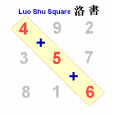 3. The Eight Trigrams
3. The Eight Trigrams
3.1. Origins of the Eight Trigrams
3.2. Binary Secret of the Hexagrams
3.3. Evolution of the Eight Trigrams
3.4. The Scheme or Map of The He
3.5. The Writing of Luo
3.6. The First Heaven Sequence
3.7. Can this Trigram be applied in real life Feng Shui audits by human beings?
3.8. Fu-Xi's Trigram (Former Heaven Sequence)
3.9. King Wen's Last Heaven Sequence Trigram (Later Heaven Sequence)
3.10. King Wen's Last Heaven Sequence Table
3.11. Devil's Gate
3.12. The Eight Trigrams and their relationships with the Four Seasons
3.13. Major Chinese Dynasties
Multiple Choice Questions: Self-Review Exercises for Units 1 to 3
Unit 4: The Ten Heavenly Stems and Twelve Earthly Branches
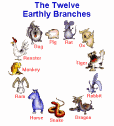 4. The Ten Heavenly Stems and Twelve Earthly Branches
4. The Ten Heavenly Stems and Twelve Earthly Branches
4.1. The Ten Heavenly Stems
4.2. The Twelve Earthly Branches
4.3. The Sexagenary Cycle
4.3.1. Finding your Sexagenary Number
4.3.2. Finding your Heavenly Stem
4.3.3. Finding your Earthly Branches
Unit 5: The Compass School of Feng Shui
 5. The Compass School of Feng Shui
5. The Compass School of Feng Shui
5.1. The 24 Compass Directions or Mountains
5.2. The Basic Directions on a Chinese Compass (Luo Pan)
5.3. The Chinese Compass or Luo Pan
5.4. Finding the Facing and Mountain Directions
5.5. A Home-made Luo Pan
5.6. Can Feng Shui be practised without using a Luo Pan?
5.7. The Three Periods and Nine Ages
5.8. The Base number calculation for the Flying Star Theory
Unit 6: Are you an East or West Group Person?
 6. Are you an East or West Group Person?
6. Are you an East or West Group Person?
6.1. East Houses
6.2. West Houses
6.3. Two methods of finding your Gua (Kua) number
6.4. When can this theory be applied?
6.5. What happens if your main door is in one of your inauspicious location?
6.6. Sleeping Positions
6.7. The Eight Aspirations Theory
6.8. The Individual Eight House Theory Templates
6.9. Good and Bad Locations
Multiple Choice Questions: Self-Review Exercises for Units 4 to 6
Unit 7: What is Qi
 7. What is Qi?
7. What is Qi?
7.1. What is Sha?
7.2. Eight Places and Locations most likely harbouring Sha
7.3. The two main objectives of Feng Shui
7.4. Flow of Qi
7.5. Three Threats from Unfavourable Qi
7.5.1 Threatening Qi
7.5.2. Lost Qi
7.5.3. Dead Qi
7.6. Counter measures against Sha
7.7. The Most Common Threats and Countermeasures
Unit 8: The Four Symbolic Animals
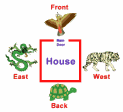 8. The Four Symbolic Animals
8. The Four Symbolic Animals
8.1. Ancient Astrological Charts of the Four Symbolic Animals
8.2. The Four Symbolic Animals Qi
8.3. Applying the Four Symbolic Animals Principle
8.3.1. Concept One
8.3.2. Concept Two
8.3.3. Concept Three
8.3.4. The White Tiger
8.3.5. West (White Tiger) Domain
8.4. Significance of Each Cardinal Direction
Unit 9: Water Qi
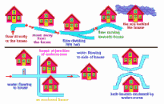 9. Water Qi
9. Water Qi
9.1. The Three Major Principles
9.1.1 Principle One
9.1.2. Principle Two
9.1.3. Principle Three
9.2. The Seven Guidelines on Water Feng Shui
9.3. Unfavourable Water Positions
9.4. Favourable Water Positions
9.5. Man-made Waterfalls, Water Fountains and Fish Tanks
Multiple Choice Questions: Self-Review Exercises for Units 7 to 9
Unit 10: Site Qi
 10. Site Qi
10. Site Qi
10.1. Factors Governing the Choice of a site
10.1.1. The Dragon
10.1.2. Foundation of the site
10.1.3. Watercourses around the site
10.1.4. The orientation of the direction of the site
10.1.5. The shapes of the plot of land
10.2. The Luo Shu Grid (A Square Formation)
10.3. Elevation or Depression on one side of the terrain
10.4. Three Rules of Thumb to assess a site
10.5. Roads and Highways
10.6. Shapes of Roofs
10.7. Trees and Plants
10.8. Classification of Plants and Flowers into the Five Elements
10.9. Case Study: The worst case of real life Sha Qi
Unit 11: The Building and House
 11. The Building and House
11. The Building and House
11.1. Shapes of Houses / Apartments: Missing Corners
11.2. Is there a cure for missing corners?
11.3. Main Door
11.4. The Living Room
11.5. The Dining Room
11.6. The Bedroom
11.7. Toilets
11.8. Cure or Remedy for the Toilet
11.9. The Kitchen
Unit 12: Symbolism in Feng Shui
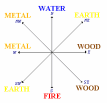 12. Symbolism in Feng Shui
12. Symbolism in Feng Shui
12.1. Colours
12.2. Ways of Altering and Improving Qi
12.2.1. Crystals
12.2.2. Decorative Ceramics
12.2.3. Mirrors
12.2.4. Guidelines for using mirrors
12.2.5. Paintings and Pictures
12.2.6. Lightings
12.2.7. Wind Chimes
12.2.8. Plants
12.2.9. Water Positions
12.3. Is there a wealth corner?
12.4. Objects and their Symbolism in Feng Shui
12.5. The various Feng Shui Schools
12.5.1. Yang Feng Shui: Earthly Luck
12.5.2. Heavenly Luck: Pillars of Destiny
12.5.3. Nine Star Ki
12.5.4. The Black Hat Sect
12.5.5. "Fast Food" Feng Shui
12.5.6. Intuition or Trial and Error Feng Shui
12.6. Is there a Career in Feng Shui?
12.7. Conducting a Feng Shui Audit
12.8. Four Guidelines to Good Feng Shui Practises
12.9. Break the Small Cage Habit
Multiple Choice Questions: Self-Review Exercises for Units 10 to 12
Self-Review Exercises
Includes a graded self-review exercise (multiple choice questions) which helps you review your understanding of the course materials.
Course Duration
The suggested length for the completion of this course is approximately 4 weeks (3 units per week).
Permanent Printable and Digital Web Certificate in Applied Feng Shui
A Permanent Printable and Digital Web Certificate in Applied Feng Shui will be issued to you once you complete your course.
Refund Policy
There will not be any full or partial refund for uncompleted courses or whatsoever.
What you will get?
1. Course Materials from the web (Total: 12 Units)
2. Personal E-mail
3. Course Performance Evaluation
4. Certificate for Applied Feng Shui (sent by mail after completion of your course)
5. Web Certificate (at your request after completion of your course)
- Hits: 310978